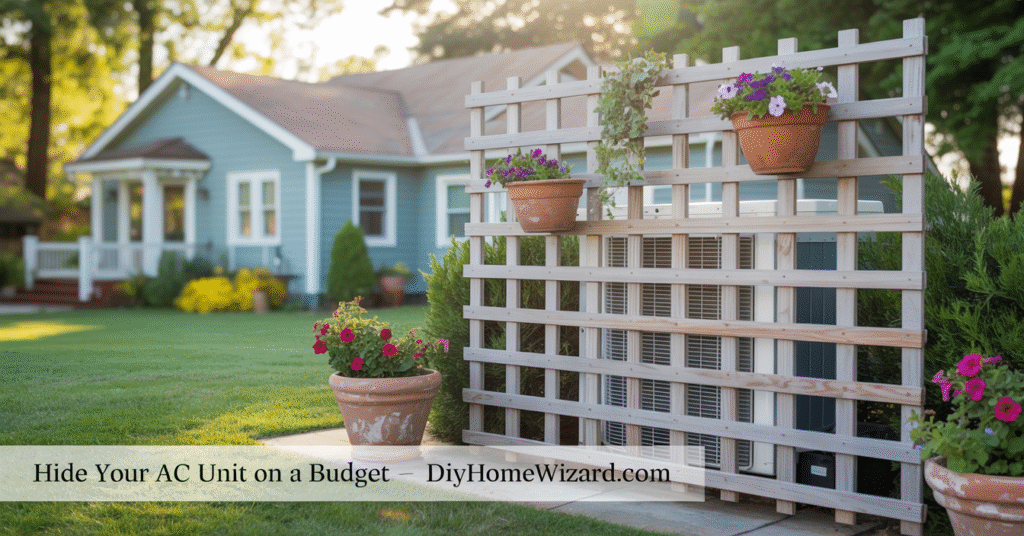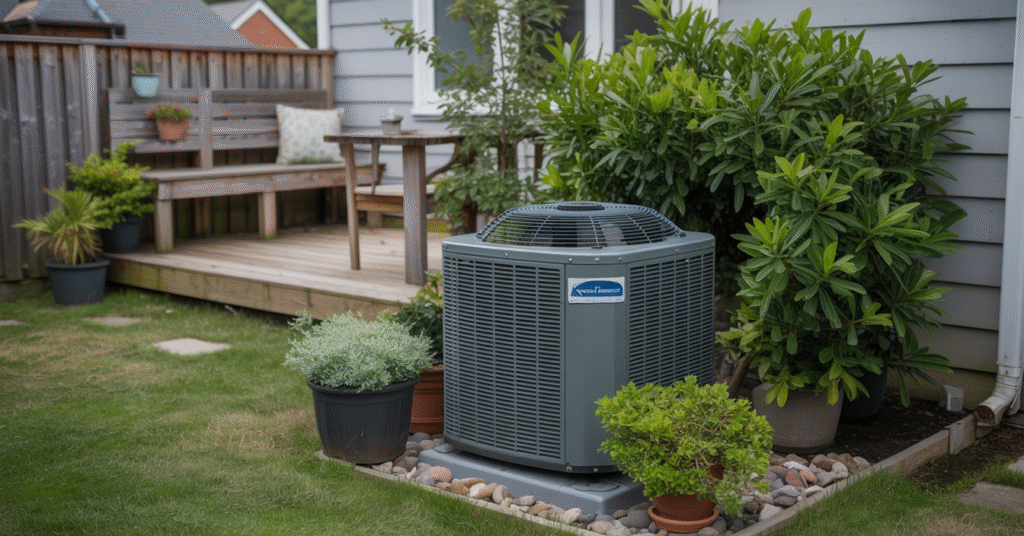
Let’s be honest — nothing ruins a beautiful backyard faster than that giant metal box humming away beside your patio. When I first started fixing up my backyard, my air conditioning unit stuck out like a sore thumb. I wanted to sit outside, drink a cold lemonade, and enjoy my little slice of peace — not stare at what looked like a leftover robot part.
So, I decided to figure out how to hide my air conditioning unit on a tight budget, and guess what? It didn’t take much money, just a little creativity, some scrap wood, and a Saturday afternoon. If you’ve ever wanted to make your outdoor space look clean, cozy, and stylish without draining your wallet, this is right up your alley.

Why Hide Your Air Conditioning Unit in the First Place?
If you’ve ever spent time landscaping or making your backyard look nice, you know how frustrating it is to have an ugly AC unit sitting right in the middle of your hard work. It’s like putting lipstick on a pig — no matter how nice everything else looks, that clunky gray box steals all the attention.
But it’s not just about looks. Hiding your air conditioning unit also has a few practical benefits:
- It reduces noise. When you put even a small barrier around it, you’ll be amazed at how much quieter it feels on your patio.
- It protects the unit from debris. A cover or screen helps keep leaves and grass clippings out of the coils.
- It boosts curb appeal. If your AC sits in a visible area, adding a simple screen or greenery can make your home instantly look cleaner and more put-together.
When I was planning out my project, I looked around for ideas to blend it into the yard. One easy trick I picked up was from my post on fast-growing plants for backyard privacy. I figured — if plants can hide the neighbors, they can definitely hide my AC unit too!
Adding a few tall shrubs or a decorative trellis made the space feel intentional instead of industrial. Plus, it added that nice touch of green that makes everything feel more natural and welcoming.
How to Hide Your Air Conditioning Unit on a Tight Budget
When you start pricing “AC covers” online, you’ll see options that make you want to run your own air conditioner just to cool off from sticker shock. Some are priced like small furniture pieces! But here’s the thing — you can absolutely do this project for cheap and have it look just as good (if not better).
Here are a few of my favorite low-cost ideas that worked for me and plenty of other DIYers:
- Repurpose old fence panels. Got a leaning or broken fence? Don’t toss it. I actually reused panels from my backyard after learning how to fix leaning fence posts. Once I straightened the good sections, the rest made a perfect base for an AC screen.
- Build a simple lattice frame. A few treated 2x2s and a sheet of lattice can go a long way. Paint or stain it to match your house or fence for a polished look.
- Use bamboo or reed fencing. These rolls are cheap, lightweight, and instantly add that “tropical” vibe. You can find them at most home improvement stores for under $40.
- Create a pallet screen. Pallets are free (or close to it) and sturdy. I’ve used pallet wood for tons of projects — from my DIY wall-mounted spice shelf to outdoor privacy screens. A little sanding and staining, and you’re golden.
If you want to get a bit more creative with the design, take some inspiration from my post about creating a rustic industrial bathroom vanity. That same mix of wood and metal looks fantastic outdoors and gives your AC area a modern, industrial charm without spending much.

Using Plants to Disguise the AC Unit Naturally
Now, if you love a good gardening project like I do, this section’s for you. Plants are hands-down one of the easiest and best-looking ways to hide your AC unit. You don’t need to build anything fancy — just use nature’s own camouflage.
Here’s what I did: I planted a few tall shrubs about two feet away from the unit (you never want to block airflow). My personal favorites are boxwoods and dwarf bamboo — they grow fast, look neat, and can handle heat pretty well. For a softer look, I added potted ferns and hanging planters nearby.
If you’re working with limited space, a few vertical planters can also do the trick. Just make sure they’re placed far enough away so your unit can breathe — no one wants to roast their plants or overwork the air conditioner.
If you want to turn this into a family project, check out family gardening fun ideas to start today. It’s amazing how much fun it can be to teach kids how plants grow while also tackling a real home improvement project.
The bonus? Your yard starts to look like something out of a magazine — colorful, fresh, and full of life. Before I knew it, that once-boring corner became my favorite little garden spot. My AC? Still there, humming quietly behind a wall of green.
Creative DIY Screens and Covers
If you’re more of a hands-on kind of person like I am, this is where the fun really starts. You can build a custom AC cover or screen that looks amazing without spending much money at all. In fact, this is one of those projects where you’ll end up asking yourself, why didn’t I do this sooner?
One of my first attempts was with leftover fence boards and a few screws. I made a simple three-sided box, left the back open for airflow, and stained it with a color that matched my deck. It instantly looked a hundred times better.
Here are a few easy, cheap ideas to get you started:
- Pallet privacy wall: Free pallets + a sander + wood stain = instant rustic charm.
- Lattice panel box: Cut two panels to size, attach them with hinges for easy access, and you’ve got a simple yet classy cover.
- Planter box combo: Build a wooden box that doubles as a planter on top. The greenery adds natural camouflage while the structure hides the AC base.
If you’ve never built something like this before, check out my project on how I built a garden arbor for under $50. It’s a great example of how you can create something that looks expensive but really isn’t.
And if you want to get more creative with recycled materials, look at building a DIY wall-mounted spice shelf. That project taught me how scrap wood can turn into something both practical and stylish — and the same goes for this AC cover idea.

Blending Your AC Cover with Outdoor Decor
Once you’ve got your screen or structure in place, the next step is to make it blend in. The last thing you want is a nice new cover that looks like a mini shed sitting awkwardly in your yard. This is where paint, lighting, and decor come in.
I painted my AC cover the same color as my house trim and then added a few small potted plants around it. Suddenly it looked like part of the design instead of a cover-up. I even hung a small sign that said “Breathe Easy” — a little corny, I know, but it made me smile.
Here are a few small touches that can make a big difference:
- Paint or stain it to match your patio furniture.
- Add solar lights — they look great at night and don’t cost a dime to run.
- Decorate with planters or wall decor to make it feel intentional.
If you need inspiration, my post on DIY soft and ambient lighting decor shows exactly how small lighting changes can transform outdoor spaces. And if you love rustic looks, peek at rustic vintage home decor ideas for enchanting spaces. Mixing textures like wood, metal, and greenery gives that “cozy cabin meets backyard oasis” vibe.
When I finished my setup, it looked so nice that people thought the AC cover was part of a garden feature — mission accomplished.
What Materials Work Best Outdoors on a Budget?
One thing I learned early on is that not all materials can survive the outdoors — especially when your AC is blowing hot air nearby. The trick is to choose materials that can handle the weather and stay looking good over time without costing a fortune.
Here are some solid, budget-friendly materials I swear by:
- Pressure-treated lumber: Holds up to rain and sun, and it’s cheap.
- Cedar or redwood: Naturally resists rot, looks great with a stain, and smells amazing.
- Vinyl lattice: Lightweight, durable, and easy to clean.
- Composite fencing: Costs a bit more upfront but lasts years with zero maintenance.
To make it last longer, seal or stain anything made of wood. I talk more about choosing between finishes in my article on stain vs paint: which lasts longer. If you do it right, your screen or cover will look sharp for years and won’t fall apart after one storm.
I went with cedar boards on mine and hit them with a quick coat of weatherproof sealant. It’s been three years now, and it still looks brand new — and cost under fifty bucks.

Mistakes to Avoid When Hiding an AC Unit
Now before you grab your drill and start building, let me save you from a few rookie mistakes that’ll cost you time, money, or both. I made one of these mistakes myself, and let’s just say it got real hot real fast.
Here are the big ones:
- Blocking airflow. Your AC needs to breathe. Keep at least 2–3 feet of open space around the sides and a few feet above the top.
- Using flammable materials. Don’t build with dry straw, cheap plastic, or thin fabric screens.
- Ignoring maintenance access. Your technician will hate you if they can’t reach the unit for service. Make sure your design opens up easily.
- Not sealing wood. It’ll rot or warp fast if left untreated outdoors.
- Covering too tightly. That’s what caused my mistake — my AC overheated and tripped the breaker. Lesson learned.
If your unit ever starts blowing warm air after making a cover, check out my guide on troubleshooting an A/C that isn’t cooling your home. It might be as simple as airflow issues or debris buildup.
Also, give the unit a good cleaning every spring. A dirty coil can reduce efficiency, even if it’s hidden behind your new stylish setup. Trust me — an hour of maintenance can save you hundreds later.

Finishing Touches for Style and Function
Once the main structure is done, this is the part where I like to add a little personality. Just because it’s a cover for an AC unit doesn’t mean it has to look plain or boring. Think of it as another small piece of your outdoor design — one that can actually add charm instead of just hiding something.
Here are a few finishing touches that can turn your simple screen into something Pinterest-worthy:
- Add color. A quick coat of paint or stain can completely change the vibe. If you’re not sure what color to pick, take a look at examples of bold and neutral color combinations for home decor. It’s amazing what a little contrast can do.
- Incorporate lighting. A small set of solar pathway lights or hanging lanterns can make your backyard feel cozy at night.
- Use stepping stones. Create a small walkway to your unit so you can access it easily for maintenance.
- Add texture. Mix materials like stone edging, wooden slats, or even gravel underneath to prevent mud from splashing onto the screen.
- Decorate smartly. I once added a small planter box filled with herbs near my cover — it looked great and made the whole space smell fresh.
If you’re on a roll with upgrading your backyard, my project on DIY projects that can increase the value of your home has even more ideas that take your outdoor areas from basic to beautiful. It’s wild how small, inexpensive upgrades like these can make your property look more polished and welcoming.
After I finished the little details on mine, it looked so nice that my neighbor asked who I hired to design it. I laughed and said, “Just me, a free Saturday, and a few leftover boards.” There’s nothing better than saving money and getting compliments.

A Budget Makeover That Actually Works
So, after all the trial and error, I can confidently say this: you don’t need a big budget to make your home look great. Learning how to hide your air conditioning unit on a tight budget turned out to be one of my favorite small DIY wins. It’s a simple project that instantly improves curb appeal, keeps your outdoor space cleaner, and makes your yard look more organized.
Whether you go with plants, wood, lattice, or a creative mix of both, you’ll be surprised how professional the end result can look. Just make sure to give your AC some breathing room, keep it service-friendly, and match the design with your yard’s overall look.
Projects like this remind me why I love doing things myself. You don’t have to spend a fortune — just use your imagination, a few affordable materials, and a little sweat equity. It’s amazing what a day’s work can do.
And if you’re itching to keep going, you can try some of my other homeowner favorites like how to repair water-damaged drywall and prevent future issues or mounting an outdoor spigot to concrete. Those little improvements make your space more functional while keeping that DIY spirit alive.
At the end of the day, making your home better doesn’t mean draining your savings — it’s about being clever, resourceful, and proud of the space you create. Now that my AC unit is neatly tucked away, my backyard finally feels like a place I want to spend time in. And honestly? That’s the best return on investment I could ask for.
As an Amazon Associate we earn from qualifying purchases through some links in our articles.



